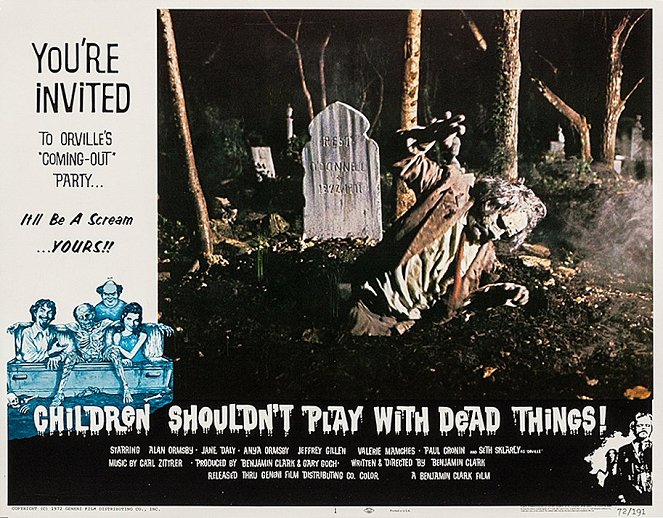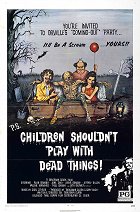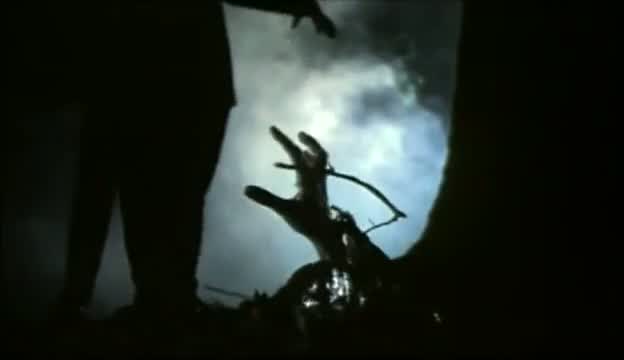Réalisation:
Bob ClarkPhotographie:
Jack McGowanMusique:
Carl ZittrerActeurs·trices:
Alan Ormsby, Valerie Mamches, Jeff Gillen, Anya Ormsby, Jane Daly, Paul Cronin, Bob Sherman, Bruce Solomon, Gordon GilbertRésumés(1)
Led by a mean-spirited director, Alan (Alan Ormsby), a theater troupe travels by boat to a small island graveyard for buried criminals. Using a grimoire, Alan begins a séance to raise the dead. The group finds more than they bargained for when the dead return from their graves, forcing the troupe to take refuge in an old abandoned caretaker’s house. Can they stay put until daylight against the undead onslaught, or do they flee into the pitch black night? Will anyone survive? (texte officiel du distributeur)
(plus)Vidéo (1)
Critiques (2)
Avant de regarder ce film de zombies, ravalez quelque peu vos attentes. Bob Clark était l’un des premiers adeptes de La Nuit des morts-vivants de George A. Romero et, en collaboration avec le scénariste Alan Ormsby (l’un des réalisateurs du relativement décent Deranged), qui a également hérité du premier rôle, il a créé une comédie d’horreur relativement discrète. Un groupe de comédiens se trouve sur une île déserte où ils s‘amusent à passer une sorte d’épreuve de courage perverse. Sous l’autorité du manipulateur maniaque Alan (Ormsby), les « enfants » du titre « jouent avec ce qui est mort » en dépassant les bornes et réveillent ainsi les morts du cimetière adjacent. Mais ne vous attendez pas à une infernale débauche de zombies dès le départ ; les morts-vivants ne se montrent que dans la troisième partie du film, ce qui va décourager la plupart des spectateurs. C’est que Clark a pris son temps avant de dévoiler le revirement tant attendu par le spectateur angoissé. En ce qui me concerne, j’ai bien aimé cette première moitié moins exubérante mais chargée de suspense et j’ai été assez satisfait par le reste.
()
Bob Clark was one of the first directors to pick up the gauntlet thrown down by George Romero, who not only fundamentally transformed the canon of pop-culture zombie mythology, but mainly used the walking dead as a catalyst for social criticism. Clark focused primarily on the latter aspect, so rather than horror, he presents a biting satire in which the zombies appear at the end as a form of divine, or rather infernal intervention. Unfortunately, the rest of the film conversely focuses on a heavily thesis-based and stiff depiction of the dynamics within a group of hippie bon vivants. As such, Clark and Alan Ormsby’s screenplay presents a caustic picture of the hippie community in the era of its decline, revealing that the internal workings of that group are subject to the same social pressures and power struggles as in mainstream society. Besides naïve and crazy people, the group is also composed of cynics, materialists and manipulators, with a charismatic leader standing at the centre of everything, though he gradually proves to be not only a manipulator and egocentric, but mainly his own construct, desperately trying to build a cult of his own personality and whose flowery speech conceals his calculating nature and systematic efforts to hide his own insignificance and pitifulness. Unfortunately, everything said in the film is delivered in an extremely stiff manner. Perhaps thanks to that, on the other hand, the excellent staging and dramatic elements shine through even more, particularly the final sequence, during which even the corpses themselves seem to marvel at the central character’s spinelessness.
()
Photos (13)
Photo © Geneni Film Distributors



Annonces